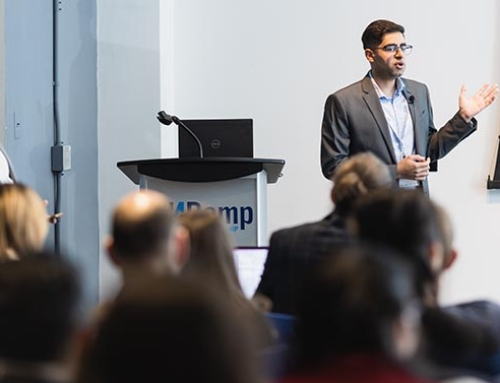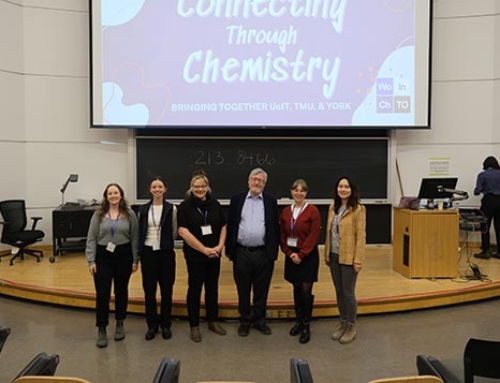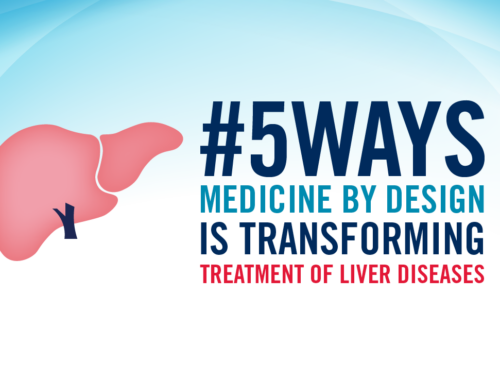
The four researchers leading teams that are sharing $1 million in funding through the Pivotal Experiment Fund. Left to right: Hai-Ling Margaret Cheng, associate professor at the Institute of Biomedical Engineering, University of Toronto; Dr. Shaf Keshavjee, surgeon-in-chief at UHN’s Sprott Department of Surgery and director of the Toronto Lung Transplant Program; Cindi Morshead, a professor and chair of the Division of Anatomy in the Department of Surgery at the University of Toronto; and Shinichiro Ogawa, affiliate scientist at the McEwen Stem Cell Institute, University Health Network.
Shinichiro Ogawa is a scientist working on developing liver cells that can be used to regenerate the liver for people with end-stage liver disease. It’s his goal to quickly translate this work to help patients.
“Before I came to Canada, I was a clinician in Japan. Now that I’m a stem cell scientist, I still have that clinical perspective,” Ogawa, who is an affiliate scientist at the McEwen Stem Cell Institute, University Health Network (UHN), says.
But Ogawa acknowledges there are funding challenges for researchers aiming to one day have their work available to patients in the clinic.
“What is needed is not just funding for academic science experiments. We need unique approaches that focus on commercializing our work. The Pivotal Experiment Fund is a very good way to fund experiments that support translating our discoveries. For me, it’s a unique opportunity for me to bring stem cell technology into the clinic.”
Ogawa, along with Hai-Ling Margaret Cheng, Dr. Shaf Keshavjee, and Cindi Morshead, will be sharing $1 million in funding to support aspects of their research that they would like to spin-off to an early-stage product concept or venture.
“This is targeted funding that addresses a real gap in the bioinnovation ecosystem,” says Michael Sefton, who is the executive director of Medicine by Design and a University Professor at the Institute of Biomedical Engineering and the Department of Chemical Engineering & Applied Chemistry, University of Toronto (U of T). “For entrepreneurial regenerative medicine researchers looking to advance their discoveries down a translational path, funding at critical early stages can be scarce.”
In Canada, governments provide most of the funding for fundamental research. But potential angel or venture capital investors or industry partners often require in-depth, pivotal data to be available before making the decision to invest.
“Researchers find themselves in a dilemma. They have a viable discovery, but they don’t have the type of ‘go/no go’ data investors want to see before they invest, and they don’t have a funding vehicle to get that data,” says Sefton, whose U of T lab is located at the Donnelly Centre for Cellular and Biomolecular Research. “What happens too many times is the idea simply dies before it can be translated into something that can make a real difference for patients in the clinic. This is often called the “valley of death” for scientific innovation.”
The Pivotal Experiment Fund is open to investigators working on Medicine by Design’s large team projects. Medicine by Design is planning to offer funding over three rounds. The first round is now complete, and the second round is currently accepting applications.
A unique feature of the Pivotal Experiment Fund is that the funding decisions are shaped by an investment review committee of leaders largely from the venture finance sphere.
“Typically, our funding decisions are reviewed by an advisory board made up of scientists,” says Sefton, who is chairing the investment review committee. “This one is made up of new venture leaders. Their perspective and expertise is so valuable to researchers who have the goal of commercializing an aspect of their research.”
A platform that tracks therapeutic cells
What happens to cells when they are used in a therapy? How many have survived? Are they working in the right areas? Hai-Ling Margaret Cheng is developing a technology that would be able to give researchers that crucial information.
“It’s a window into the body,” says Cheng. “In a cell therapy, even a small mistarget could have big implications. We need to know the fate of cells after they are injected,” says Cheng, who is an associate professor at the Institute of Biomedical Engineering, U of T.
Her lab’s platform applies a colour to the cells that are being tracked, which she calls “labelling” the cells. These cells can then be tracked using magnetic resonance imaging (MRI) technology, providing valuable information to researchers.
Cheng’s team is currently looking at two stem cell therapy applications of the technology: heart failure and spinal cord injury. Eventually though, she could see her technology being used to track other stem cell therapy treatments like pancreatic cells for diabetes or liver cells for liver failure.
Cheng is developing this technology along with co-investigators Dr. Michael Laflamme, senior scientist, at UHN’s McEwen Stem Cell Institute, and associate professor at the Department of Laboratory Medicine & Pathobiology at U of T; and Dr. Michael G. Fehlings, senior scientist, Krembil Research Institute, UHN, and professor of neurosurgery at U of T.
This funding will help Cheng’s team reach a few remaining objectives. She says her team needs to demonstrate that the labelling process does not hurt the therapeutic capacity of the cells. The team also must optimize the platform based on the cells types they are using — a type of heart cell and a type of brain cell — and demonstrate that it outperforms the current gold standard technology.
“This system that we’ve developed is sensitive and specific,” Cheng says. “It’s non-invasive and has high spatial resolution.”
Cheng sees both a short-term and long-term application of the technology.
“The most immediate use for the platform is people who work in preclinical research, to be utilized to improve the results of the research,” says Cheng. “I’m also optimistic that this will one day be available to help patients directly as a non-invasive way to monitor their stem cell therapies.”
She adds, “There is very little funding out there for researchers who want data to convince investors that their concept is sound. Funding to do comparisons, optimize aspects of your work or demonstrate the universality of your product is hard to come by. I am grateful to Medicine by Design for enabling this to come to fruition.”
Improving lungs for transplant with a novel technique
Dr. Shaf Keshavjee, surgeon-in-chief at UHN’s Sprott Department of Surgery and director of the Toronto Lung Transplant Program, is part of a team of researchers who invented technology for lung transplants that is now in worldwide use, the Toronto Ex Vivo Lung Perfusion (EVLP) system.
There is a large demand in Canada, where one patient dies every eight days due to the current donor lung shortage, for lung transplants. The International Society for Heart and Lung Transplantation estimates that 80% of donor lungs are declined for transplant because of their poor condition. The EVLP system gives clinicians a chance to treat the lungs before transplantation, improving their condition and making more available to patients.
The EVLP system keeps donated lungs outside the body for as long as possible so medical teams can get them in good enough shape to transplant into patients who need them.
“The EVLP system is like an ICU bed for the lung,” explains Keshavjee, who is also a professor of thoracic surgery at U of T. “We’ve developed rapid tests that allow us to interrogate the organ, see what’s wrong with it and then plan what we need to do to improve it for transplantation. This is an excellent example of personalized medicine.”
But the EVLP system currently has limitations. It’s duration for lung preservation is about 6 hours, and Keshavjee says he believes that by introducing a novel clinical hardware that incorporates dialysis technology with the EVLP, the team can increase preservation to 48 hours. Keshavjee is working with co-investigator Dr. Mingyao Liu, a senior scientist at the Toronto General Hospital Research Institute and a professor of physiology at U of T, on this project.
“Extending the time we can assess and repair the lung will rescue more lungs and mean more patients — and ideally all patients — who need lung transplants will receive them,” says Keshavjee.
He adds, “Developing this technology, with help from Medicine by Design’s Pivotal Experiment Fund, will mean people will spend significantly less time on Canada’s transplant wait list, and begin timely recovery at a much faster rate.”
Gene therapy to solve two problems at once
Stroke does two things to the brain, says Cindi Morshead, a professor and chair of the Division of Anatomy in the Department of Surgery at U of T. It kills neurons, the fundamental cells of the brain; and it causes a specific type of brain cell, called an astrocyte, to become toxic, which can kill even more neurons.
“We are on track to develop a gene therapy that can efficiently reprogram that astrocyte back into a functional neuron,” Morshead says. “You are then solving two problems at once. You are adding more desperately-needed neurons, and you are getting rid of that toxic astrocyte before it can cause more damage.”
The Pivotal Experiment Fund will support Morshead, whose lab is located at the Donnelly Centre for Cellular and Biomolecular Research, in her work developing the therapy for direct reprogramming of brain cells, leading to better recovery among people who’ve had stroke.
More than 50,000 Canadians have a stroke each year, and 85 per cent of them will survive. But large numbers of people who’ve experienced stroke, around 75 per cent, will be left with mild to severe impairments that can include vision problems, memory issues, mobility challenges, paralysis and many more effects.
There are not many treatment options for those who have had stroke, and recovery for these individuals tends to plateau, says Morshead.
Without the Pivotal Experiment Fund, she says, it would be a challenge to get this type of research done. Morshead is working with Medicine by Design co-investigators Carol Schuurmans, a senior scientist at Sunnybrook Research Institute and professor of biochemistry at U of T, and Maryam Faiz, an assistant professor in the Department of Surgery at U of T. JoAnne McLaurin, senior scientists at Sunnybrook Research Institute and professor in the Department of Laboratory Medicine & Pathobiology at U of T, is also a collaborator on the project.
“We really need this type of funding. Because of Medicine by Design’s vision, our team will be able to continue work we’ve already been funded to do, and in a way that’s more targeted to commercialize our research into something that can really help patients who don’t have a lot of options.”
Morshead and her team see this work also applying more broadly to any disease that causes brain degeneration such as Alzheimer’s disease or amyotrophic lateral sclerosis (ALS).
Taking steps toward regenerating the liver with liver cells
Ogawa’s work centres around developing hepatocytes — the main functional cells of the liver that perform many of the tasks that keep it functioning as it should — in the lab to use as a therapy.
Currently, the only option available for people with end-stage liver disease is an organ transplant, and there is a shortage of donor organs. More than 500 liver transplants are performed annually in Canada. Approximately 15 to 25 per cent of potential transplant patients die while waiting for a donor organ.
Ogawa can see his cell therapy’s first clinical application being for patients awaiting an organ transplant. His lab-made hepatocytes would be given to the patient, which would regenerate the liver enough to extend the time the patient is able to wait for a donor organ — meaning more patients would survive the wait.
His long-term vision is that an organ transplant would not be needed because it will be possible to repair and regenerate the liver of patients with end-stage liver disease with his cell therapy.
But there are challenges in developing this new type of therapy, which Ogawa’s team plans to address through their Pivotal Experiment Fund research.
“The problem with using regenerative cell therapies is that the patient’s immune system might reject the transplanted cells,” Ogawa says. “We anticipate that combining gene editing techniques and 3D bioprinting technologies will allow us to create an immunoprotected cell product that will not be rejected.”
The project has three co-investigators: Gordon Keller, director of the McEwen Stem Cell Institute and a senior scientist at The Princess Margaret Cancer Centre at UHN, and a professor in medical biophysics at U of T; Sonya MacParland, scientist at Toronto General Hospital Research Institute, UHN, and an associate professor in the departments of Immunology and Laboratory Medicine and Pathobiology at U of T; and Dr. Ian McGilvray, liver transplant surgeon and senior scientist at UHN’s Ajmera Transplant Center, Toronto General Hospital, and a professor of general surgery at U of T.
Beginning with a human pluripotent stem cell, which are cells that can turn into any type of cell in the body, Ogawa’s team can create hepatocytes. Their Pivotal Experiment Fund will help the team to develop a method to encapsulate the cells with an immune-protected material. The challenge then is scaling cell manufacturing so enough cells can be produced to treat patients.
“The liver is the largest organ in the body,” Ogawa, who is also an assistant professor at the Department of Laboratory Medicine & Pathobiology at U of T, says. “You need a lot of cells for this type of therapy; anywhere from one billion to 10 billion per patient. The Pivotal Experiment Fund will allow us to develop a method for scaling production of these cells.”
About Medicine by Design
Funded by a $114-million grant from the Canada First Research Excellence Fund, Medicine by Design brings together more than 150 principal investigators at the University of Toronto and its affiliated hospitals to advance regenerative medicine discoveries and accelerate them toward impact. It builds on decades of made-in-Canada excellence in regenerative medicine dating back to the discovery of stem cells in the early 1960s by Toronto researchers James Till and Dr. Ernest McCulloch.





